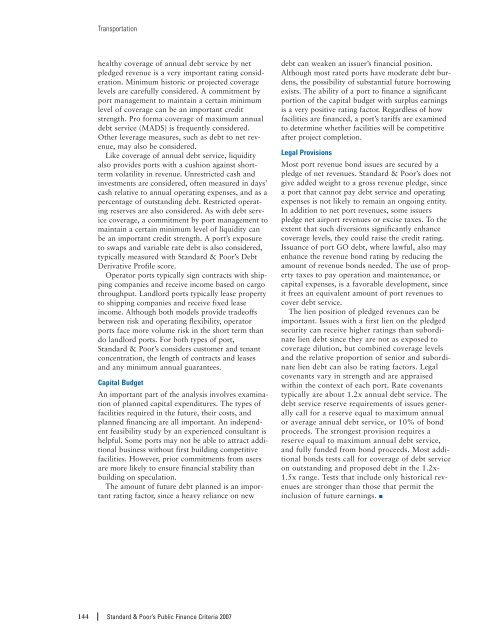S&P - Public Finance Criteria (2007). - The Global Clearinghouse
S&P - Public Finance Criteria (2007). - The Global Clearinghouse
S&P - Public Finance Criteria (2007). - The Global Clearinghouse
Create successful ePaper yourself
Turn your PDF publications into a flip-book with our unique Google optimized e-Paper software.
Transportationhealthy coverage of annual debt service by netpledged revenue is a very important rating consideration.Minimum historic or projected coveragelevels are carefully considered. A commitment byport management to maintain a certain minimumlevel of coverage can be an important creditstrength. Pro forma coverage of maximum annualdebt service (MADS) is frequently considered.Other leverage measures, such as debt to net revenue,may also be considered.Like coverage of annual debt service, liquidityalso provides ports with a cushion against shorttermvolatility in revenue. Unrestricted cash andinvestments are considered, often measured in days’cash relative to annual operating expenses, and as apercentage of outstanding debt. Restricted operatingreserves are also considered. As with debt servicecoverage, a commitment by port management tomaintain a certain minimum level of liquidity canbe an important credit strength. A port’s exposureto swaps and variable rate debt is also considered,typically measured with Standard & Poor’s DebtDerivative Profile score.Operator ports typically sign contracts with shippingcompanies and receive income based on cargothroughput. Landlord ports typically lease propertyto shipping companies and receive fixed leaseincome. Although both models provide tradeoffsbetween risk and operating flexibility, operatorports face more volume risk in the short term thando landlord ports. For both types of port,Standard & Poor’s considers customer and tenantconcentration, the length of contracts and leasesand any minimum annual guarantees.Capital BudgetAn important part of the analysis involves examinationof planned capital expenditures. <strong>The</strong> types offacilities required in the future, their costs, andplanned financing are all important. An independentfeasibility study by an experienced consultant ishelpful. Some ports may not be able to attract additionalbusiness without first building competitivefacilities. However, prior commitments from usersare more likely to ensure financial stability thanbuilding on speculation.<strong>The</strong> amount of future debt planned is an importantrating factor, since a heavy reliance on newdebt can weaken an issuer’s financial position.Although most rated ports have moderate debt burdens,the possibility of substantial future borrowingexists. <strong>The</strong> ability of a port to finance a significantportion of the capital budget with surplus earningsis a very positive rating factor. Regardless of howfacilities are financed, a port’s tariffs are examinedto determine whether facilities will be competitiveafter project completion.Legal ProvisionsMost port revenue bond issues are secured by apledge of net revenues. Standard & Poor’s does notgive added weight to a gross revenue pledge, sincea port that cannot pay debt service and operatingexpenses is not likely to remain an ongoing entity.In addition to net port revenues, some issuerspledge net airport revenues or excise taxes. To theextent that such diversions significantly enhancecoverage levels, they could raise the credit rating.Issuance of port GO debt, where lawful, also mayenhance the revenue bond rating by reducing theamount of revenue bonds needed. <strong>The</strong> use of propertytaxes to pay operation and maintenance, orcapital expenses, is a favorable development, sinceit frees an equivalent amount of port revenues tocover debt service.<strong>The</strong> lien position of pledged revenues can beimportant. Issues with a first lien on the pledgedsecurity can receive higher ratings than subordinatelien debt since they are not as exposed tocoverage dilution, but combined coverage levelsand the relative proportion of senior and subordinatelien debt can also be rating factors. Legalcovenants vary in strength and are appraisedwithin the context of each port. Rate covenantstypically are about 1.2x annual debt service. <strong>The</strong>debt service reserve requirements of issues generallycall for a reserve equal to maximum annualor average annual debt service, or 10% of bondproceeds. <strong>The</strong> strongest provision requires areserve equal to maximum annual debt service,and fully funded from bond proceeds. Most additionalbonds tests call for coverage of debt serviceon outstanding and proposed debt in the 1.2x-1.5x range. Tests that include only historical revenuesare stronger than those that permit theinclusion of future earnings. ■144 Standard & Poor’s <strong>Public</strong> <strong>Finance</strong> <strong>Criteria</strong> <strong>2007</strong>
















